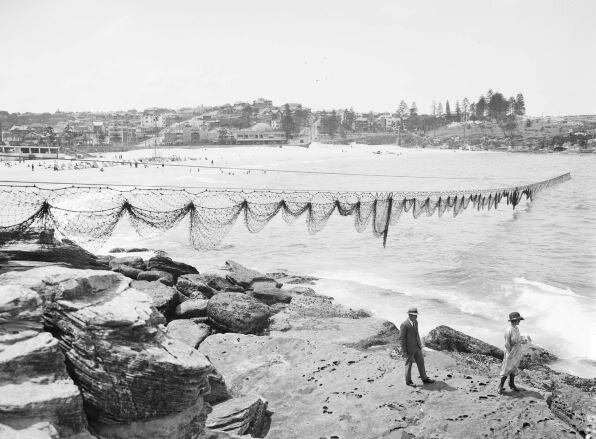Disentangling Shark Nets
Shark nets and barriers are probably the most well-known of all shark mitigation tools, the defining symbol of mankind’s mission to turn the ocean into a swimming pool.
Their first full use was at Coogee in New South Wales, Australia, from 1929. It was not a promising start- the opening ceremony having to be postponed after a cable snapped, embarrassing contractors. Some had been used privately before. A 1928 article in the Honolulu Star-Bulletin discussed plans by wealthy Hilo yacht club members to fund repairs to the worn shark net protecting the club’s marina. By the early 30s, a small few locations around the world, like Durban in South Africa had a netted beach, but it was still New South Wales that led the way, compelled by a growing shark fear, after a spike in fatalities in the 20s and early 30s. Yet it was understood and accepted by the authorities that these fixtures could never fully cover and protect a beach and their main purpose was viewed as the catching and killing of large sharks before they entered a swimming area.
A photograph of the first shark net, at Coogee, NSW in the 1920s (photo: AE Foster, State Library of NSW)
Another form of defense that emerged was the fenced-off enclosure, such as the ‘shark-proof wonder pool’ at Manly Harbour, which also became popular in Australia as a way to protect bathers. Built in 1931, it could hold up to 5,000 bathers at a time, allowing Sydneysiders to enjoy the Harbour’s water but with the added security of wooden barriers.
A postcard of Manly’s ‘shark-proof wonder pool’ in Middle Harbour, Sydney
From 1952, the South African state of Natal followed New South Wales’s example, erecting netting at a considerable number of its beaches. Then in 1962, NSW’s neighbour Queensland also adopted widespread meshing. Many advocates argue the evidence of these measures reducing the risk of shark attack has been strong. For instance, in the 75 years since it was introduced across Sydney city beaches, there has only been one fatality, in spite of a large growth in human population and water recreation. Since 1962, meshed beaches in Queensland have recorded only two deaths, compared to 27 from 1919 to 1961. Critics contend these declines are not due to nets, but the general devastation of shark populations or misinterpretation of the data. Where the distinction between causation and correlation lies is still uncertain in the debate.
What is certain however, is that the tide has begun to turn against shark nets in recent decades. Conservationists, nature documentary makers and many others have highlighted the harm done to marine life by this mitigation strategy, causing indiscriminate injury and death, and not just to ‘target sharks’. For instance, in the period 2018-2019, shark nets in New South Wales killed 284 sea creatures- including 7 protected dolphins, 38 rays, 6 turtles and 99 hammerhead sharks. Tens of thousands more animals have met a similar fate over its contentious history of netted beaches.
An unlucky turtle entangled in a shark net, a death listed as one of a ‘non-target species’
Last week, the state of New South Wales made an announcement that signaled a major step towards ending the practice of netting it had first begun. The world’s largest shark management program is set to go ahead in the coming weeks and months. A combination of 37 listening stations to track tagged sharks, 100 non-lethal SMART drumlines for catch and release, and a fleet of shark-alert drones will be used to give peace of mind to water users. For now, protective meshing remains in place in many locations in Sydney, Wollongong and Newcastle while these alternatives are being put to the test. Alongside advancing technology and attitudes, these once-cherished nets look increasingly like relics of a different time as they head towards the centenary of their use in New South Wales.
Westpac drones are piloted by lifeguards to spot sharks, send alerts and even offer assistance to swimmers in trouble
In contrast, the shark barrier, as pioneered at Manly Harbour 80 years ago may in fact have life in it yet. In recent years, ‘eco-shark barriers’ and ‘exclusion nets’ have been trialed and rolled out successfully at Fish Hoek, South Africa, at Cottesloe, Western Australia, and at Coogee Beach, where the catch-all shark nets were first set. The new barriers create exclusion swimming zones where no large marine animals can enter, but crucially, are designed to do so without causing them harm or degrading the surrounding environment. In these places at least, it would seem mankind’s mission to turn the ocean into a swimming pool has finally, peacefully, been realised.
Eco Shark Barrier at Coogee Beach, NSW (Photo: City of Cockburn Council)





